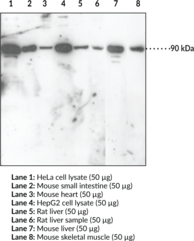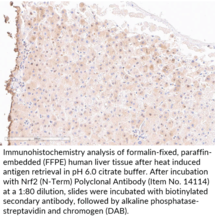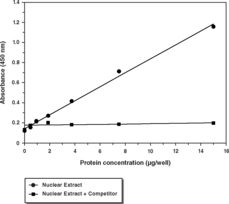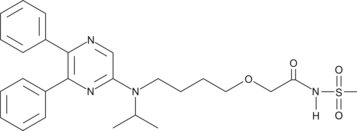Cayman
Showing 32551–32700 of 45550 results
-
NPS 1034 is a dual inhibitor of the receptor tyrosine kinase activities of MET (IC50 = 48 nM) and AXL (IC50 = 10.3 nM), receptors for hepatocyte growth factor and vitamin K-dependent proteins, respectively.{33325} It synergistically inhibits cell proliferation when used in combination with gefitinib (Item No. 13166) or erlotinib (Item No. 10483) in NSCLC cells with acquired resistance to EGFR receptor tyrosine kinase inhibitors.{33325} NPS 1034 inhibits autophosphorylation of numerous constitutively active mutant forms of MET (IC50s <25 nM) and inhibits the invasion and migration of MET mutant-transfected cells.{33326} It also inhibits growth of MKN45 xenograft tumors in mice treated orally with 30 mg/kg NPS 1034 for 25 days.{33326}
Brand:CaymanSKU:19627 -Available on backorder
NPS 1034 is a dual inhibitor of the receptor tyrosine kinase activities of MET (IC50 = 48 nM) and AXL (IC50 = 10.3 nM), receptors for hepatocyte growth factor and vitamin K-dependent proteins, respectively.{33325} It synergistically inhibits cell proliferation when used in combination with gefitinib (Item No. 13166) or erlotinib (Item No. 10483) in NSCLC cells with acquired resistance to EGFR receptor tyrosine kinase inhibitors.{33325} NPS 1034 inhibits autophosphorylation of numerous constitutively active mutant forms of MET (IC50s <25 nM) and inhibits the invasion and migration of MET mutant-transfected cells.{33326} It also inhibits growth of MKN45 xenograft tumors in mice treated orally with 30 mg/kg NPS 1034 for 25 days.{33326}
Brand:CaymanSKU:19627 -Available on backorder
Calcium-sensing receptor (CaSR) is a G protein-coupled receptor that is involved in calcium homeostasis.{29237,26276} Activation of CaSR on parathyroid cells decreases the secretion of parathyroid hormone (PTH), which in turn reduces blood calcium concentration.{29237,26276} NPS 2143 is a potent and selective antagonist of CaSR (IC50 = 43 nM) that stimulates PTH secretion from parathyroid cells in vitro (EC50 = 39 nM).{29235,29236} It is effective in vivo, causing a sustained increase in plasma PTH in rats when given intravenously.{29235,29236} Daily oral administration of NPS 2143 to osteopenic ovariectomized rats results in a dramatic increase in bone turnover, as well as increased circulating PTH levels.{29235}
Brand:CaymanSKU:-Available on backorder
Calcium-sensing receptor (CaSR) is a G protein-coupled receptor that is involved in calcium homeostasis.{29237,26276} Activation of CaSR on parathyroid cells decreases the secretion of parathyroid hormone (PTH), which in turn reduces blood calcium concentration.{29237,26276} NPS 2143 is a potent and selective antagonist of CaSR (IC50 = 43 nM) that stimulates PTH secretion from parathyroid cells in vitro (EC50 = 39 nM).{29235,29236} It is effective in vivo, causing a sustained increase in plasma PTH in rats when given intravenously.{29235,29236} Daily oral administration of NPS 2143 to osteopenic ovariectomized rats results in a dramatic increase in bone turnover, as well as increased circulating PTH levels.{29235}
Brand:CaymanSKU:-Available on backorder
Calcium-sensing receptor (CaSR) is a G protein-coupled receptor that is involved in calcium homeostasis.{29237,26276} Activation of CaSR on parathyroid cells decreases the secretion of parathyroid hormone (PTH), which in turn reduces blood calcium concentration.{29237,26276} NPS 2143 is a potent and selective antagonist of CaSR (IC50 = 43 nM) that stimulates PTH secretion from parathyroid cells in vitro (EC50 = 39 nM).{29235,29236} It is effective in vivo, causing a sustained increase in plasma PTH in rats when given intravenously.{29235,29236} Daily oral administration of NPS 2143 to osteopenic ovariectomized rats results in a dramatic increase in bone turnover, as well as increased circulating PTH levels.{29235}
Brand:CaymanSKU:-Available on backorder
Calcium-sensing receptor (CaSR) is a G protein-coupled receptor that is involved in calcium homeostasis.{29237,26276} Activation of CaSR on parathyroid cells decreases the secretion of parathyroid hormone (PTH), which in turn reduces blood calcium concentration.{29237,26276} NPS 2143 is a potent and selective antagonist of CaSR (IC50 = 43 nM) that stimulates PTH secretion from parathyroid cells in vitro (EC50 = 39 nM).{29235,29236} It is effective in vivo, causing a sustained increase in plasma PTH in rats when given intravenously.{29235,29236} Daily oral administration of NPS 2143 to osteopenic ovariectomized rats results in a dramatic increase in bone turnover, as well as increased circulating PTH levels.{29235}
Brand:CaymanSKU:-Available on backorder
Metabotropic glutamate receptors (mGluRs), mediate excitatory synaptic transmission in the central nervous system. Potent and selective antagonists of the type I mGluRs (mGluR1 and mGluR5) are of interest as novel therapeutics for the treatment of various CNS disorders, such as pain, epilepsy, and stroke.{21993,21995} NPS 2390 is a first generation quinoxaline derivative that acts as a noncompetitive antagonist of mGluR1 and mGluR5 with IC50 values equal to 5.2 and 82 nM, respectively).{21992} At concentrations up to 30 μM, NPS 2390 does not affect mGluR2 or mGluR8 or a standard collection of 37 additional receptors, ion channels, and enzymes.{21992} At a dose of 10 mg/kg, NPS 2390 displaced the specifically bound mGlu1R-selective antagonist, [3H]R214127, in rat cerebellum.{21994}
Brand:CaymanSKU:11989 - 10 mgAvailable on backorder
Metabotropic glutamate receptors (mGluRs), mediate excitatory synaptic transmission in the central nervous system. Potent and selective antagonists of the type I mGluRs (mGluR1 and mGluR5) are of interest as novel therapeutics for the treatment of various CNS disorders, such as pain, epilepsy, and stroke.{21993,21995} NPS 2390 is a first generation quinoxaline derivative that acts as a noncompetitive antagonist of mGluR1 and mGluR5 with IC50 values equal to 5.2 and 82 nM, respectively).{21992} At concentrations up to 30 μM, NPS 2390 does not affect mGluR2 or mGluR8 or a standard collection of 37 additional receptors, ion channels, and enzymes.{21992} At a dose of 10 mg/kg, NPS 2390 displaced the specifically bound mGlu1R-selective antagonist, [3H]R214127, in rat cerebellum.{21994}
Brand:CaymanSKU:11989 - 25 mgAvailable on backorder
Metabotropic glutamate receptors (mGluRs), mediate excitatory synaptic transmission in the central nervous system. Potent and selective antagonists of the type I mGluRs (mGluR1 and mGluR5) are of interest as novel therapeutics for the treatment of various CNS disorders, such as pain, epilepsy, and stroke.{21993,21995} NPS 2390 is a first generation quinoxaline derivative that acts as a noncompetitive antagonist of mGluR1 and mGluR5 with IC50 values equal to 5.2 and 82 nM, respectively).{21992} At concentrations up to 30 μM, NPS 2390 does not affect mGluR2 or mGluR8 or a standard collection of 37 additional receptors, ion channels, and enzymes.{21992} At a dose of 10 mg/kg, NPS 2390 displaced the specifically bound mGlu1R-selective antagonist, [3H]R214127, in rat cerebellum.{21994}
Brand:CaymanSKU:11989 - 5 mgAvailable on backorder
NQ301 is a naphthoquinone with diverse biological activities, including antiplatelet, antithrombotic, anti-inflammatory, and antimicrobial properties.{46244,46245,46246,46247} It inhibits rabbit platelet aggregation induced by the thromboxane A2 receptor agonist U-46619 (Item No. 16450) in vitro (IC50 = 0.58 μM) and inhibits the conversion of arachidonic acid to thromboxane B2 in rabbit platelets in a concentration-dependent manner.{46244} It also inhibits human platelet aggregation induced by ADP, collagen, epinephrine, and the calcium ionophore A23187 in vitro (IC50s = 3.21, 15.69, 8.44, and 44.2 μM, respectively).{46245} NQ301 (50 and 100 mg/kg) increases tail bleeding time and exhibits a protective effect against pulmonary thrombosis in mice. It inhibits the protein tyrosine phosphatase CD45 with an IC50 value of 0.29 μM.{46246} NQ301 (3 mg/kg) inhibits ovalbumin-induced footpad swelling in a mouse model of delayed-type hypersensitivity. It is also active against C. albicans, A. niger, B. subtilis, S. aureus, E. coli, and P. aeruginosa (MICs = 12.5-50 μg/ml).{46247}
Brand:CaymanSKU:21958 -Out of stock
NQ301 is a naphthoquinone with diverse biological activities, including antiplatelet, antithrombotic, anti-inflammatory, and antimicrobial properties.{46244,46245,46246,46247} It inhibits rabbit platelet aggregation induced by the thromboxane A2 receptor agonist U-46619 (Item No. 16450) in vitro (IC50 = 0.58 μM) and inhibits the conversion of arachidonic acid to thromboxane B2 in rabbit platelets in a concentration-dependent manner.{46244} It also inhibits human platelet aggregation induced by ADP, collagen, epinephrine, and the calcium ionophore A23187 in vitro (IC50s = 3.21, 15.69, 8.44, and 44.2 μM, respectively).{46245} NQ301 (50 and 100 mg/kg) increases tail bleeding time and exhibits a protective effect against pulmonary thrombosis in mice. It inhibits the protein tyrosine phosphatase CD45 with an IC50 value of 0.29 μM.{46246} NQ301 (3 mg/kg) inhibits ovalbumin-induced footpad swelling in a mouse model of delayed-type hypersensitivity. It is also active against C. albicans, A. niger, B. subtilis, S. aureus, E. coli, and P. aeruginosa (MICs = 12.5-50 μg/ml).{46247}
Brand:CaymanSKU:21958 -Out of stock
NQ301 is a naphthoquinone with diverse biological activities, including antiplatelet, antithrombotic, anti-inflammatory, and antimicrobial properties.{46244,46245,46246,46247} It inhibits rabbit platelet aggregation induced by the thromboxane A2 receptor agonist U-46619 (Item No. 16450) in vitro (IC50 = 0.58 μM) and inhibits the conversion of arachidonic acid to thromboxane B2 in rabbit platelets in a concentration-dependent manner.{46244} It also inhibits human platelet aggregation induced by ADP, collagen, epinephrine, and the calcium ionophore A23187 in vitro (IC50s = 3.21, 15.69, 8.44, and 44.2 μM, respectively).{46245} NQ301 (50 and 100 mg/kg) increases tail bleeding time and exhibits a protective effect against pulmonary thrombosis in mice. It inhibits the protein tyrosine phosphatase CD45 with an IC50 value of 0.29 μM.{46246} NQ301 (3 mg/kg) inhibits ovalbumin-induced footpad swelling in a mouse model of delayed-type hypersensitivity. It is also active against C. albicans, A. niger, B. subtilis, S. aureus, E. coli, and P. aeruginosa (MICs = 12.5-50 μg/ml).{46247}
Brand:CaymanSKU:21958 -Out of stock
NQ301 is a naphthoquinone with diverse biological activities, including antiplatelet, antithrombotic, anti-inflammatory, and antimicrobial properties.{46244,46245,46246,46247} It inhibits rabbit platelet aggregation induced by the thromboxane A2 receptor agonist U-46619 (Item No. 16450) in vitro (IC50 = 0.58 μM) and inhibits the conversion of arachidonic acid to thromboxane B2 in rabbit platelets in a concentration-dependent manner.{46244} It also inhibits human platelet aggregation induced by ADP, collagen, epinephrine, and the calcium ionophore A23187 in vitro (IC50s = 3.21, 15.69, 8.44, and 44.2 μM, respectively).{46245} NQ301 (50 and 100 mg/kg) increases tail bleeding time and exhibits a protective effect against pulmonary thrombosis in mice. It inhibits the protein tyrosine phosphatase CD45 with an IC50 value of 0.29 μM.{46246} NQ301 (3 mg/kg) inhibits ovalbumin-induced footpad swelling in a mouse model of delayed-type hypersensitivity. It is also active against C. albicans, A. niger, B. subtilis, S. aureus, E. coli, and P. aeruginosa (MICs = 12.5-50 μg/ml).{46247}
Brand:CaymanSKU:21958 -Out of stock
Apoptosis signal-regulating kinase 1 (ASK1) is the ubiquitously expressed mitogen-activated protein kinase kinase kinase 5 involved in a wide range of biological functions that are dependent on cell survival or death.{10689,26710} NQDI-1 is a specific inhibitor of ASK1 (IC50 = 3 μM; Ki = 500 nM) that demonstrates potent selectivity against various serine/threonine and tyrosine protein kinases.{26710} It has been used to promote survival of induced pluripotent stem cell populations and to protect neurons from reactive oxygen species-induced apoptosis in a model of ischemia.{26712,26711}
Brand:CaymanSKU:-Apoptosis signal-regulating kinase 1 (ASK1) is the ubiquitously expressed mitogen-activated protein kinase kinase kinase 5 involved in a wide range of biological functions that are dependent on cell survival or death.{10689,26710} NQDI-1 is a specific inhibitor of ASK1 (IC50 = 3 μM; Ki = 500 nM) that demonstrates potent selectivity against various serine/threonine and tyrosine protein kinases.{26710} It has been used to promote survival of induced pluripotent stem cell populations and to protect neurons from reactive oxygen species-induced apoptosis in a model of ischemia.{26712,26711}
Brand:CaymanSKU:-Apoptosis signal-regulating kinase 1 (ASK1) is the ubiquitously expressed mitogen-activated protein kinase kinase kinase 5 involved in a wide range of biological functions that are dependent on cell survival or death.{10689,26710} NQDI-1 is a specific inhibitor of ASK1 (IC50 = 3 μM; Ki = 500 nM) that demonstrates potent selectivity against various serine/threonine and tyrosine protein kinases.{26710} It has been used to promote survival of induced pluripotent stem cell populations and to protect neurons from reactive oxygen species-induced apoptosis in a model of ischemia.{26712,26711}
Brand:CaymanSKU:-Apoptosis signal-regulating kinase 1 (ASK1) is the ubiquitously expressed mitogen-activated protein kinase kinase kinase 5 involved in a wide range of biological functions that are dependent on cell survival or death.{10689,26710} NQDI-1 is a specific inhibitor of ASK1 (IC50 = 3 μM; Ki = 500 nM) that demonstrates potent selectivity against various serine/threonine and tyrosine protein kinases.{26710} It has been used to promote survival of induced pluripotent stem cell populations and to protect neurons from reactive oxygen species-induced apoptosis in a model of ischemia.{26712,26711}
Brand:CaymanSKU:-NQTrp is an inhibitor of Alzheimer’s disease-associated amyloid β (Aβ) oligomerization and fibrillization (IC50 = 50 nM for formation of fibrils from Aβ1-42).{31208,31209} It has been shown to reduce the cytotoxic effect of Aβ oligomers in a cultured neuronal cell line.{31208}
Brand:CaymanSKU:-Available on backorder
NQTrp is an inhibitor of Alzheimer’s disease-associated amyloid β (Aβ) oligomerization and fibrillization (IC50 = 50 nM for formation of fibrils from Aβ1-42).{31208,31209} It has been shown to reduce the cytotoxic effect of Aβ oligomers in a cultured neuronal cell line.{31208}
Brand:CaymanSKU:-Available on backorder
NQTrp is an inhibitor of Alzheimer’s disease-associated amyloid β (Aβ) oligomerization and fibrillization (IC50 = 50 nM for formation of fibrils from Aβ1-42).{31208,31209} It has been shown to reduce the cytotoxic effect of Aβ oligomers in a cultured neuronal cell line.{31208}
Brand:CaymanSKU:-Available on backorder
NQTrp is an inhibitor of Alzheimer’s disease-associated amyloid β (Aβ) oligomerization and fibrillization (IC50 = 50 nM for formation of fibrils from Aβ1-42).{31208,31209} It has been shown to reduce the cytotoxic effect of Aβ oligomers in a cultured neuronal cell line.{31208}
Brand:CaymanSKU:-Available on backorder
Immunogen: Synthetic peptide from the C-terminal region of human Nrf2 protein • Host: Rabbit • Species Reactivity: (+) Human, mouse, rat • Cross Reactivity: N/A • Applications: FC, ICC, IF, WB • MW = 90 kDa
Brand:CaymanSKU:10214- 1 eaNuclear factor erythroid 2-related factor 2 (Nrf2) is a basic leucine zipper transcription factor encoded by NFE2L2 in humans that regulates the cellular antioxidant response.{53865} It is a 605-amino acid protein comprised of seven highly conserved Nrf2-ECH (Neh) homology domains.{53866,53867} Nrf2 contains a large central domain that recruits transcriptional co-activators, mediates heterodimerization with the transcription factor Maf, and can be phosphorylated by GSK3 or the ubiquitin ligase adapter protein β-TrCP.{53868,53867} The Nrf2 central domain is flanked by an N-terminal Neh2 domain that binds the negative regulator Kelch-like ECH-associated protein 1 (Keap1; Item No. 32035) and a C-terminal Neh3 domain that is required for transactivation.{53867} Nrf2 is ubiquitously expressed and, under homeostatic conditions, associates with Keap1 in the cytoplasm, preventing Nrf2 nuclear translocation and promoting its ubiquitination and proteasomal degradation.{53866,53869} In the presence of xenobiotic electrophiles or oxidants, Keap1 releases Nrf2 which translocates to the nucleus, dimerizes with Maf, and induces the expression of a variety of cytoprotective genes that have antioxidant, anti-inflammatory, and metabolic functions.{53870,53745,53865} Nrf2 siRNA knockdown increases DNA-crosslinking and apoptosis induced by cisplatin (Item No. 13119) in A549 cancer cells, indicating that Nrf2 contributes to chemoresistance.{53871} Tumor Nrf2 levels are increased in patients with non-small cell lung cancer (NSCLC) and this increase is associated with poor overall survival.{53872} Cayman’s Nrf2 (C-Term) Polyclonal Antibody can be used for flow cytometry (FC), immunocytochemistry (ICC), immunofluorescence (IF), and Western blot (WB) applications. The antibody preferentially recognizes polyubiquitinated Nrf2 at 90 kDa from human, mouse, and rat samples.
Brand:CaymanSKU:10214 - 1 eaAvailable on backorder
Immunogen: Synthetic peptide from the C-terminal region of human Nrf2 protein • Host: Rabbit • Species Reactivity: (+) Human, mouse, rat • Cross Reactivity: N/A • Applications: FC, ICC, IF, WB • MW = 90 kDa
Brand:CaymanSKU:10214- 1 eaAvailable on backorder
Nuclear factor erythroid 2-related factor 2 (Nrf2) is a basic leucine zipper transcription factor encoded by NFE2L2 in humans that regulates the cellular antioxidant response.{53865} It is a 605-amino acid protein comprised of seven highly conserved Nrf2-ECH (Neh) homology domains.{53866,53867} Nrf2 contains a large central domain that recruits transcriptional co-activators, mediates heterodimerization with the transcription factor Maf, and can be phosphorylated by GSK3 or the ubiquitin ligase adapter protein β-TrCP.{53867,53868} The Nrf2 central domain is flanked by an N-terminal Neh2 domain that binds the negative regulator Kelch-like ECH-associated protein 1 (Keap1; Item No. 32035) and a C-terminal Neh3 domain that is required for transactivation.{53867} Nrf2 is ubiquitously expressed and, under homeostatic conditions, associates with Keap1 in the cytoplasm, preventing Nrf2 nuclear translocation and promoting its ubiquitination and proteasomal degradation.{53866,53869} In the presence of xenobiotic electrophiles or oxidants, Keap1 releases Nrf2 which translocates to the nucleus, dimerizes with Maf, and induces the expression of a variety of cytoprotective genes that have antioxidant, anti-inflammatory, and metabolic functions.{53865,53870,53745} Nrf2 siRNA knockdown increases DNA-crosslinking and apoptosis induced by cisplatin (Item No. 13119) in A549 cancer cells, indicating that Nrf2 contributes to chemoresistance.{53871} Tumor Nrf2 levels are increased in patients with non-small cell lung cancer (NSCLC) and this increase is associated with poor overall survival.{53872} Cayman’s Nrf2 (N-Term) Polyclonal Antibody can be used for flow cytometry (FC), immunocytochemistry (ICC), and Western blot (WB) applications. The antibody recognizes native and polyubiquitinated Nrf2 at 67 and 90 kDa, respectively, from human, mouse, and rat samples.
Brand:CaymanSKU:14114 - 1 eaAvailable on backorder
Immunogen: Peptide from the N-terminal region of human Nrf2 protein • Host: Rabbit • Species Reactivity: (+) Human, mouse, rat • Applications: FC, ICC, IF, WB • MW = 67 and 90 kDa for native and polyubiquitinated Nrf2, respectively
Brand:CaymanSKU:14114- 1 eaAvailable on backorder
Immunogen: Peptide from the N-terminal region of human Nrf2 protein • Host: Rabbit • Species Reactivity: (+) Human, mouse, rat • Applications: FC, ICC, IF, WB • MW = 67 and 90 kDa for native and polyubiquitinated Nrf2, respectively
Brand:CaymanSKU:14114- 1 eaNuclear factor E2-related factor 2 (Nrf2) is a transcription factor that plays a key role in maintaining redox homeostasis via its interaction with a cysteine-rich protein Kelch-like ECH-associated protein 1 (Keap1). In resting cells, Nrf2 and Keap1 form a tight complex, which is targeted for degradation by proteasomes. Under oxidative stress, Nrf2 is released from the Nrf2/Keap1 complex and translocates to the nucleus where it is able to induce the expression of a battery of genes encoding diverse cytoprotective proteins, including antioxidative enzymes, anti-inflammatory mediators, and proteasomes. Cayman’s Nrf2 Transcription Factor Assay is a non-radioactive, colorimetric method for detecting specific transcription factor DNA binding activity in nuclear extracts. A specific double stranded DNA (dsDNA) sequence containing the Nrf2 response element is immobilized onto the wells of a 96-well plate. Nrf2 contained in nuclear extract samples will bind specifically to the Nrf2 response element and can be detected by addition of a specific Nrf2 antibody and a secondary antibody conjugated to HRP.
Brand:CaymanSKU:600590 - 96 wellsAvailable on backorder
NS 11021 is an activator of large-conductance Ca2+-activated potassium channels (BKCa/KCa1.1).{32423} It is selective for BKCa and is thought to bind directly the ɑ subunit.{32423} NS 11021 has been shown to relax intracavernous arterial rings and corpus cavernosum strips in vitro and to enhance erectile responses in intact rats.{32424}
Brand:CaymanSKU:-NS 11021 is an activator of large-conductance Ca2+-activated potassium channels (BKCa/KCa1.1).{32423} It is selective for BKCa and is thought to bind directly the ɑ subunit.{32423} NS 11021 has been shown to relax intracavernous arterial rings and corpus cavernosum strips in vitro and to enhance erectile responses in intact rats.{32424}
Brand:CaymanSKU:-NS 11021 is an activator of large-conductance Ca2+-activated potassium channels (BKCa/KCa1.1).{32423} It is selective for BKCa and is thought to bind directly the ɑ subunit.{32423} NS 11021 has been shown to relax intracavernous arterial rings and corpus cavernosum strips in vitro and to enhance erectile responses in intact rats.{32424}
Brand:CaymanSKU:-NS 11021 is an activator of large-conductance Ca2+-activated potassium channels (BKCa/KCa1.1).{32423} It is selective for BKCa and is thought to bind directly the ɑ subunit.{32423} NS 11021 has been shown to relax intracavernous arterial rings and corpus cavernosum strips in vitro and to enhance erectile responses in intact rats.{32424}
Brand:CaymanSKU:-NS 11394 is an orally bioavailable positive allosteric modulator of the GABAA receptor (Ki = 0.423 nM in rat cortical membranes).{36345} It is selective for GABAA receptors containing α1, α2, α3, or α5 subunits (Kis = 0.41, 0.84, 0.497, and 0.119 nM, respectively) over receptors containing α4 or α6 subunits (Kis = 324 or 1,009 nM, respectively). In X. laevis oocytes, NS 11394 modulates GABA responses via receptors containing the subunits α3 and α5, with maximal potentiation rates of 52% and 78%, respectively, relative to diazepam (Item No. ISO60177). In vivo, NS 11394 inhibits the binding of [3H]flunitrazepam to benzodiazepine receptors in the forebrain of mice and rats, with respective EC50 values of 0.38 and 1.3 mg/kg at 30 minutes and 0.49 and 0.69 mg/kg at 120 minutes following oral administration. NS 11394 (1-30 mg/kg) attenuates spontaneous nociceptive behaviors to formalin and capsaicin (Item No. 92350) injections in a rat model of neuropathic pain.{36346}
Brand:CaymanSKU:23872 - 1 mgAvailable on backorder
NS 11394 is an orally bioavailable positive allosteric modulator of the GABAA receptor (Ki = 0.423 nM in rat cortical membranes).{36345} It is selective for GABAA receptors containing α1, α2, α3, or α5 subunits (Kis = 0.41, 0.84, 0.497, and 0.119 nM, respectively) over receptors containing α4 or α6 subunits (Kis = 324 or 1,009 nM, respectively). In X. laevis oocytes, NS 11394 modulates GABA responses via receptors containing the subunits α3 and α5, with maximal potentiation rates of 52% and 78%, respectively, relative to diazepam (Item No. ISO60177). In vivo, NS 11394 inhibits the binding of [3H]flunitrazepam to benzodiazepine receptors in the forebrain of mice and rats, with respective EC50 values of 0.38 and 1.3 mg/kg at 30 minutes and 0.49 and 0.69 mg/kg at 120 minutes following oral administration. NS 11394 (1-30 mg/kg) attenuates spontaneous nociceptive behaviors to formalin and capsaicin (Item No. 92350) injections in a rat model of neuropathic pain.{36346}
Brand:CaymanSKU:23872 - 10 mgAvailable on backorder
NS 11394 is an orally bioavailable positive allosteric modulator of the GABAA receptor (Ki = 0.423 nM in rat cortical membranes).{36345} It is selective for GABAA receptors containing α1, α2, α3, or α5 subunits (Kis = 0.41, 0.84, 0.497, and 0.119 nM, respectively) over receptors containing α4 or α6 subunits (Kis = 324 or 1,009 nM, respectively). In X. laevis oocytes, NS 11394 modulates GABA responses via receptors containing the subunits α3 and α5, with maximal potentiation rates of 52% and 78%, respectively, relative to diazepam (Item No. ISO60177). In vivo, NS 11394 inhibits the binding of [3H]flunitrazepam to benzodiazepine receptors in the forebrain of mice and rats, with respective EC50 values of 0.38 and 1.3 mg/kg at 30 minutes and 0.49 and 0.69 mg/kg at 120 minutes following oral administration. NS 11394 (1-30 mg/kg) attenuates spontaneous nociceptive behaviors to formalin and capsaicin (Item No. 92350) injections in a rat model of neuropathic pain.{36346}
Brand:CaymanSKU:23872 - 25 mgAvailable on backorder
NS 11394 is an orally bioavailable positive allosteric modulator of the GABAA receptor (Ki = 0.423 nM in rat cortical membranes).{36345} It is selective for GABAA receptors containing α1, α2, α3, or α5 subunits (Kis = 0.41, 0.84, 0.497, and 0.119 nM, respectively) over receptors containing α4 or α6 subunits (Kis = 324 or 1,009 nM, respectively). In X. laevis oocytes, NS 11394 modulates GABA responses via receptors containing the subunits α3 and α5, with maximal potentiation rates of 52% and 78%, respectively, relative to diazepam (Item No. ISO60177). In vivo, NS 11394 inhibits the binding of [3H]flunitrazepam to benzodiazepine receptors in the forebrain of mice and rats, with respective EC50 values of 0.38 and 1.3 mg/kg at 30 minutes and 0.49 and 0.69 mg/kg at 120 minutes following oral administration. NS 11394 (1-30 mg/kg) attenuates spontaneous nociceptive behaviors to formalin and capsaicin (Item No. 92350) injections in a rat model of neuropathic pain.{36346}
Brand:CaymanSKU:23872 - 5 mgAvailable on backorder
NS 1619 is a calcium-dependent activator of large-conductance Ca2+-activated K+ (BKCa) channels in vascular smooth muscle.{30652} It is typically used at a concentration of 30 µM to hyperpolarize the membrane potential of single myocytes during studies of smooth muscle relaxation and vasodilation.{30656,30653} Studies suggest that activation of BKCa channels by NS 1619 can protect the cardiac muscle against pulmonary hypertension as well as ischemia and reperfusion injury in various animal models.{30655,30654}
Brand:CaymanSKU:-Available on backorder
NS 1619 is a calcium-dependent activator of large-conductance Ca2+-activated K+ (BKCa) channels in vascular smooth muscle.{30652} It is typically used at a concentration of 30 µM to hyperpolarize the membrane potential of single myocytes during studies of smooth muscle relaxation and vasodilation.{30656,30653} Studies suggest that activation of BKCa channels by NS 1619 can protect the cardiac muscle against pulmonary hypertension as well as ischemia and reperfusion injury in various animal models.{30655,30654}
Brand:CaymanSKU:-Available on backorder
NS 1619 is a calcium-dependent activator of large-conductance Ca2+-activated K+ (BKCa) channels in vascular smooth muscle.{30652} It is typically used at a concentration of 30 µM to hyperpolarize the membrane potential of single myocytes during studies of smooth muscle relaxation and vasodilation.{30656,30653} Studies suggest that activation of BKCa channels by NS 1619 can protect the cardiac muscle against pulmonary hypertension as well as ischemia and reperfusion injury in various animal models.{30655,30654}
Brand:CaymanSKU:-Available on backorder
NS 1619 is a calcium-dependent activator of large-conductance Ca2+-activated K+ (BKCa) channels in vascular smooth muscle.{30652} It is typically used at a concentration of 30 µM to hyperpolarize the membrane potential of single myocytes during studies of smooth muscle relaxation and vasodilation.{30656,30653} Studies suggest that activation of BKCa channels by NS 1619 can protect the cardiac muscle against pulmonary hypertension as well as ischemia and reperfusion injury in various animal models.{30655,30654}
Brand:CaymanSKU:-Available on backorder
NS 1643 is an activator of the human ether-a-go-go related gene (ERG1, KCNH2, hERG) KV11.1 channel (EC50 = 10.5 μM).{32589,32591} It also activates the KV11.2 (ERG2, KCNH6) channel, but evokes a distinctly different response from that of KV11.1.{32590} NS 1643 is commonly used in cells or isolated tissues.{32589,32591,32592}
Brand:CaymanSKU:20343 -Available on backorder
NS 1643 is an activator of the human ether-a-go-go related gene (ERG1, KCNH2, hERG) KV11.1 channel (EC50 = 10.5 μM).{32589,32591} It also activates the KV11.2 (ERG2, KCNH6) channel, but evokes a distinctly different response from that of KV11.1.{32590} NS 1643 is commonly used in cells or isolated tissues.{32589,32591,32592}
Brand:CaymanSKU:20343 -Available on backorder
NS 1643 is an activator of the human ether-a-go-go related gene (ERG1, KCNH2, hERG) KV11.1 channel (EC50 = 10.5 μM).{32589,32591} It also activates the KV11.2 (ERG2, KCNH6) channel, but evokes a distinctly different response from that of KV11.1.{32590} NS 1643 is commonly used in cells or isolated tissues.{32589,32591,32592}
Brand:CaymanSKU:20343 -Available on backorder
NS 1643 is an activator of the human ether-a-go-go related gene (ERG1, KCNH2, hERG) KV11.1 channel (EC50 = 10.5 μM).{32589,32591} It also activates the KV11.2 (ERG2, KCNH6) channel, but evokes a distinctly different response from that of KV11.1.{32590} NS 1643 is commonly used in cells or isolated tissues.{32589,32591,32592}
Brand:CaymanSKU:20343 -Available on backorder
NS 1738 is a positive allosteric modulator of the α7-containing neuronal nicotinic acetylcholine receptors (nAChRs).{29720} When applied in the presence of ACh, NS 1738 increases the peak amplitude of the current flowing through α7-containing nAChRs (EC50 = 3.4 µM).{29720} NS 1738 displays no substantial activity for α4β2-, α3β3-, and α1-containing receptors. It is modestly brain-penetrant and counteracts (-)-scopolamine-induced deficit in acquisition of a water-maze learning task in rats.{29720} NS 1738 also improves performance in the rat social recognition test.{29720} NS 1738 is used to selectively evaluate the role of α7-containing nAChRs in signaling pathways.{33287,33288}
Brand:CaymanSKU:21018 -Out of stock
NS 1738 is a positive allosteric modulator of the α7-containing neuronal nicotinic acetylcholine receptors (nAChRs).{29720} When applied in the presence of ACh, NS 1738 increases the peak amplitude of the current flowing through α7-containing nAChRs (EC50 = 3.4 µM).{29720} NS 1738 displays no substantial activity for α4β2-, α3β3-, and α1-containing receptors. It is modestly brain-penetrant and counteracts (-)-scopolamine-induced deficit in acquisition of a water-maze learning task in rats.{29720} NS 1738 also improves performance in the rat social recognition test.{29720} NS 1738 is used to selectively evaluate the role of α7-containing nAChRs in signaling pathways.{33287,33288}
Brand:CaymanSKU:21018 -Out of stock
NS 1738 is a positive allosteric modulator of the α7-containing neuronal nicotinic acetylcholine receptors (nAChRs).{29720} When applied in the presence of ACh, NS 1738 increases the peak amplitude of the current flowing through α7-containing nAChRs (EC50 = 3.4 µM).{29720} NS 1738 displays no substantial activity for α4β2-, α3β3-, and α1-containing receptors. It is modestly brain-penetrant and counteracts (-)-scopolamine-induced deficit in acquisition of a water-maze learning task in rats.{29720} NS 1738 also improves performance in the rat social recognition test.{29720} NS 1738 is used to selectively evaluate the role of α7-containing nAChRs in signaling pathways.{33287,33288}
Brand:CaymanSKU:21018 -Out of stock
NS 6180 is an inhibitor of the intermediate-conductance calcium-activated potassium channel 3.1 (IKCa1/KCa3.1; IC50 = 9.4 nM in HEK293 cells expressing the human channel).{43059} It inhibits hyperpolarization of human, mouse, and rat erythrocytes induced by the calcium ionophore A23187 (Item No. 11016) (IC50s = 14, 15, and 9 nM, respectively). NS 6180 is selective for IKCa1/KCa3.1 over voltage-gated sodium (Nav) and most voltage-gated potassium channels (Kv) but does inhibit KCa1.1, Kv1.3, and Kv11.1 channels by greater than 50% at 10 µM. It is selective for potassium channels over G protein-coupled receptors and ion channels, inhibiting only the norepinephrine and dopamine transporters, L-type calcium channel, and melatonin receptor MT1 by greater than 50% in a panel of 69 receptors and channels. NS 6180 inhibits T-lymphocyte activation and the release of the Th1 cytokines IL-2 and IFN-γ in vitro (IC50 = ~50 nM). It also increases proliferation of natural killer (NK) cells and selectively increases cytotoxicity of adherent, but not non-adherent, NK cells.{43560} In a rat model of inflammatory bowel disease (IBD) induced by DNBS, NS 6180 (3 and 10 mg/kg per day) decreases colon inflammation and improves weight gain.{43059}
Brand:CaymanSKU:-NS 6180 is an inhibitor of the intermediate-conductance calcium-activated potassium channel 3.1 (IKCa1/KCa3.1; IC50 = 9.4 nM in HEK293 cells expressing the human channel).{43059} It inhibits hyperpolarization of human, mouse, and rat erythrocytes induced by the calcium ionophore A23187 (Item No. 11016) (IC50s = 14, 15, and 9 nM, respectively). NS 6180 is selective for IKCa1/KCa3.1 over voltage-gated sodium (Nav) and most voltage-gated potassium channels (Kv) but does inhibit KCa1.1, Kv1.3, and Kv11.1 channels by greater than 50% at 10 µM. It is selective for potassium channels over G protein-coupled receptors and ion channels, inhibiting only the norepinephrine and dopamine transporters, L-type calcium channel, and melatonin receptor MT1 by greater than 50% in a panel of 69 receptors and channels. NS 6180 inhibits T-lymphocyte activation and the release of the Th1 cytokines IL-2 and IFN-γ in vitro (IC50 = ~50 nM). It also increases proliferation of natural killer (NK) cells and selectively increases cytotoxicity of adherent, but not non-adherent, NK cells.{43560} In a rat model of inflammatory bowel disease (IBD) induced by DNBS, NS 6180 (3 and 10 mg/kg per day) decreases colon inflammation and improves weight gain.{43059}
Brand:CaymanSKU:-NS 6180 is an inhibitor of the intermediate-conductance calcium-activated potassium channel 3.1 (IKCa1/KCa3.1; IC50 = 9.4 nM in HEK293 cells expressing the human channel).{43059} It inhibits hyperpolarization of human, mouse, and rat erythrocytes induced by the calcium ionophore A23187 (Item No. 11016) (IC50s = 14, 15, and 9 nM, respectively). NS 6180 is selective for IKCa1/KCa3.1 over voltage-gated sodium (Nav) and most voltage-gated potassium channels (Kv) but does inhibit KCa1.1, Kv1.3, and Kv11.1 channels by greater than 50% at 10 µM. It is selective for potassium channels over G protein-coupled receptors and ion channels, inhibiting only the norepinephrine and dopamine transporters, L-type calcium channel, and melatonin receptor MT1 by greater than 50% in a panel of 69 receptors and channels. NS 6180 inhibits T-lymphocyte activation and the release of the Th1 cytokines IL-2 and IFN-γ in vitro (IC50 = ~50 nM). It also increases proliferation of natural killer (NK) cells and selectively increases cytotoxicity of adherent, but not non-adherent, NK cells.{43560} In a rat model of inflammatory bowel disease (IBD) induced by DNBS, NS 6180 (3 and 10 mg/kg per day) decreases colon inflammation and improves weight gain.{43059}
Brand:CaymanSKU:-NS 6180 is an inhibitor of the intermediate-conductance calcium-activated potassium channel 3.1 (IKCa1/KCa3.1; IC50 = 9.4 nM in HEK293 cells expressing the human channel).{43059} It inhibits hyperpolarization of human, mouse, and rat erythrocytes induced by the calcium ionophore A23187 (Item No. 11016) (IC50s = 14, 15, and 9 nM, respectively). NS 6180 is selective for IKCa1/KCa3.1 over voltage-gated sodium (Nav) and most voltage-gated potassium channels (Kv) but does inhibit KCa1.1, Kv1.3, and Kv11.1 channels by greater than 50% at 10 µM. It is selective for potassium channels over G protein-coupled receptors and ion channels, inhibiting only the norepinephrine and dopamine transporters, L-type calcium channel, and melatonin receptor MT1 by greater than 50% in a panel of 69 receptors and channels. NS 6180 inhibits T-lymphocyte activation and the release of the Th1 cytokines IL-2 and IFN-γ in vitro (IC50 = ~50 nM). It also increases proliferation of natural killer (NK) cells and selectively increases cytotoxicity of adherent, but not non-adherent, NK cells.{43560} In a rat model of inflammatory bowel disease (IBD) induced by DNBS, NS 6180 (3 and 10 mg/kg per day) decreases colon inflammation and improves weight gain.{43059}
Brand:CaymanSKU:-NS 8593 is an inhibitory gating modifier of small conductance calcium-activated potassium (SK) channels (Kds = 0.42, 0.6, and 0.73 μM for SK1, SK2, and SK3, respectively, in the presence of calcium) that decreases the calcium sensitivity of SK channels.{53292} It is selective for SK channels over intermediate (IK) and large conductance (BK) potassium channels at 10 μM. NS 8593 induces relaxation of potassium- or acetylcholine chloride-precontracted isolated tracheal rings from wild-type mice (IC50s = 8.9 and 39.8 μM, respectively) or from mice in an ovalbumin-induced model of allergic asthma (IC50s = 16.4 and 32.2 μM, respectively).{53293} It inhibits aerosolized acetylcholine chloride-induced increases in respiratory system resistance in mice when administered as an aerosol at a dose of 500 μM. NS 8593 (5 mg/kg) decreases the duration of burst-pacing-induced atrial fibrillation in normotensive and spontaneously hypertensive rats.{53294}
Brand:CaymanSKU:29774 - 1 mgAvailable on backorder
NS 8593 is an inhibitory gating modifier of small conductance calcium-activated potassium (SK) channels (Kds = 0.42, 0.6, and 0.73 μM for SK1, SK2, and SK3, respectively, in the presence of calcium) that decreases the calcium sensitivity of SK channels.{53292} It is selective for SK channels over intermediate (IK) and large conductance (BK) potassium channels at 10 μM. NS 8593 induces relaxation of potassium- or acetylcholine chloride-precontracted isolated tracheal rings from wild-type mice (IC50s = 8.9 and 39.8 μM, respectively) or from mice in an ovalbumin-induced model of allergic asthma (IC50s = 16.4 and 32.2 μM, respectively).{53293} It inhibits aerosolized acetylcholine chloride-induced increases in respiratory system resistance in mice when administered as an aerosol at a dose of 500 μM. NS 8593 (5 mg/kg) decreases the duration of burst-pacing-induced atrial fibrillation in normotensive and spontaneously hypertensive rats.{53294}
Brand:CaymanSKU:29774 - 10 mgAvailable on backorder
NS 8593 is an inhibitory gating modifier of small conductance calcium-activated potassium (SK) channels (Kds = 0.42, 0.6, and 0.73 μM for SK1, SK2, and SK3, respectively, in the presence of calcium) that decreases the calcium sensitivity of SK channels.{53292} It is selective for SK channels over intermediate (IK) and large conductance (BK) potassium channels at 10 μM. NS 8593 induces relaxation of potassium- or acetylcholine chloride-precontracted isolated tracheal rings from wild-type mice (IC50s = 8.9 and 39.8 μM, respectively) or from mice in an ovalbumin-induced model of allergic asthma (IC50s = 16.4 and 32.2 μM, respectively).{53293} It inhibits aerosolized acetylcholine chloride-induced increases in respiratory system resistance in mice when administered as an aerosol at a dose of 500 μM. NS 8593 (5 mg/kg) decreases the duration of burst-pacing-induced atrial fibrillation in normotensive and spontaneously hypertensive rats.{53294}
Brand:CaymanSKU:29774 - 25 mgAvailable on backorder
NS 8593 is an inhibitory gating modifier of small conductance calcium-activated potassium (SK) channels (Kds = 0.42, 0.6, and 0.73 μM for SK1, SK2, and SK3, respectively, in the presence of calcium) that decreases the calcium sensitivity of SK channels.{53292} It is selective for SK channels over intermediate (IK) and large conductance (BK) potassium channels at 10 μM. NS 8593 induces relaxation of potassium- or acetylcholine chloride-precontracted isolated tracheal rings from wild-type mice (IC50s = 8.9 and 39.8 μM, respectively) or from mice in an ovalbumin-induced model of allergic asthma (IC50s = 16.4 and 32.2 μM, respectively).{53293} It inhibits aerosolized acetylcholine chloride-induced increases in respiratory system resistance in mice when administered as an aerosol at a dose of 500 μM. NS 8593 (5 mg/kg) decreases the duration of burst-pacing-induced atrial fibrillation in normotensive and spontaneously hypertensive rats.{53294}
Brand:CaymanSKU:29774 - 5 mgAvailable on backorder
NS 9283 is a positive allosteric modulator of α4β2 subunit-containing nicotinic acetylcholine receptors (nAChRs) that potentiates ACh-induced currents in HEK293 cells expressing human α4β2 subunit-containing nAChRs (EC50 = 4 μM).{53135} In vivo, NS 9283 potentiates ABT-594 (Item No. 22822) analgesic efficacy in rat models of carrageenan-induced thermal hyperalgesia, paw skin incision post-operative pain, and monoiodoacetate-induced osteoarthritis.{53136} It reduces nicotine, but not sucrose, self-administration and reinstatement in rats when administered at a dose of 3.5 mg/kg.{53137}
Brand:CaymanSKU:29189 - 1 mgAvailable on backorder
NS 9283 is a positive allosteric modulator of α4β2 subunit-containing nicotinic acetylcholine receptors (nAChRs) that potentiates ACh-induced currents in HEK293 cells expressing human α4β2 subunit-containing nAChRs (EC50 = 4 μM).{53135} In vivo, NS 9283 potentiates ABT-594 (Item No. 22822) analgesic efficacy in rat models of carrageenan-induced thermal hyperalgesia, paw skin incision post-operative pain, and monoiodoacetate-induced osteoarthritis.{53136} It reduces nicotine, but not sucrose, self-administration and reinstatement in rats when administered at a dose of 3.5 mg/kg.{53137}
Brand:CaymanSKU:29189 - 10 mgAvailable on backorder
NS 9283 is a positive allosteric modulator of α4β2 subunit-containing nicotinic acetylcholine receptors (nAChRs) that potentiates ACh-induced currents in HEK293 cells expressing human α4β2 subunit-containing nAChRs (EC50 = 4 μM).{53135} In vivo, NS 9283 potentiates ABT-594 (Item No. 22822) analgesic efficacy in rat models of carrageenan-induced thermal hyperalgesia, paw skin incision post-operative pain, and monoiodoacetate-induced osteoarthritis.{53136} It reduces nicotine, but not sucrose, self-administration and reinstatement in rats when administered at a dose of 3.5 mg/kg.{53137}
Brand:CaymanSKU:29189 - 25 mgAvailable on backorder
NS 9283 is a positive allosteric modulator of α4β2 subunit-containing nicotinic acetylcholine receptors (nAChRs) that potentiates ACh-induced currents in HEK293 cells expressing human α4β2 subunit-containing nAChRs (EC50 = 4 μM).{53135} In vivo, NS 9283 potentiates ABT-594 (Item No. 22822) analgesic efficacy in rat models of carrageenan-induced thermal hyperalgesia, paw skin incision post-operative pain, and monoiodoacetate-induced osteoarthritis.{53136} It reduces nicotine, but not sucrose, self-administration and reinstatement in rats when administered at a dose of 3.5 mg/kg.{53137}
Brand:CaymanSKU:29189 - 5 mgAvailable on backorder
NS-2028 is a specific inhibitor of soluble guanylyl cyclase. It inhibits purified bovine lung guanylyl cyclase in a concentration dependent and irreversible manner with IC50 values of 30 and 200 nM for basal and NO-stimulated enzymes, respectively.{6642} S-nitroso-glutathione-enhanced guanylyl cyclase activity in mouse cerebellum homogenates is inhibited by NS-2028 with an IC50 value of 17 nM, making it about 4.7 fold more potent than ODQ, which has an IC50 value of 80 nM for inhibition of soluble guanylyl cyclase in the same assay.{6642} NS-2028 does not inhibit particulate guanylyl cyclase or adenylyl cyclase.
Brand:CaymanSKU:81600 - 1 mgAvailable on backorder
NS-2028 is a specific inhibitor of soluble guanylyl cyclase. It inhibits purified bovine lung guanylyl cyclase in a concentration dependent and irreversible manner with IC50 values of 30 and 200 nM for basal and NO-stimulated enzymes, respectively.{6642} S-nitroso-glutathione-enhanced guanylyl cyclase activity in mouse cerebellum homogenates is inhibited by NS-2028 with an IC50 value of 17 nM, making it about 4.7 fold more potent than ODQ, which has an IC50 value of 80 nM for inhibition of soluble guanylyl cyclase in the same assay.{6642} NS-2028 does not inhibit particulate guanylyl cyclase or adenylyl cyclase.
Brand:CaymanSKU:81600 - 10 mgAvailable on backorder
NS-2028 is a specific inhibitor of soluble guanylyl cyclase. It inhibits purified bovine lung guanylyl cyclase in a concentration dependent and irreversible manner with IC50 values of 30 and 200 nM for basal and NO-stimulated enzymes, respectively.{6642} S-nitroso-glutathione-enhanced guanylyl cyclase activity in mouse cerebellum homogenates is inhibited by NS-2028 with an IC50 value of 17 nM, making it about 4.7 fold more potent than ODQ, which has an IC50 value of 80 nM for inhibition of soluble guanylyl cyclase in the same assay.{6642} NS-2028 does not inhibit particulate guanylyl cyclase or adenylyl cyclase.
Brand:CaymanSKU:81600 - 25 mgAvailable on backorder
NS-2028 is a specific inhibitor of soluble guanylyl cyclase. It inhibits purified bovine lung guanylyl cyclase in a concentration dependent and irreversible manner with IC50 values of 30 and 200 nM for basal and NO-stimulated enzymes, respectively.{6642} S-nitroso-glutathione-enhanced guanylyl cyclase activity in mouse cerebellum homogenates is inhibited by NS-2028 with an IC50 value of 17 nM, making it about 4.7 fold more potent than ODQ, which has an IC50 value of 80 nM for inhibition of soluble guanylyl cyclase in the same assay.{6642} NS-2028 does not inhibit particulate guanylyl cyclase or adenylyl cyclase.
Brand:CaymanSKU:81600 - 5 mgAvailable on backorder
Prostaglandin I2 (PGI2) is a potent vasorelaxant and inhibitor of human platelet aggregation that mediates its actions by binding to a specific G protein-coupled receptor, the IP receptor, on the surface of endothelial cells and platelets.{4375} The IP receptor also participates in signal transduction of the pain response, cardioprotection, and inflammation.{9050,5018,9805,8508,5466} NS-304 is a prodrug of the active form of MRE-269, which is a potent and selective agonist for the human IP receptor with a Ki value of 20 nM.{14998} In contrast to prostaglandin I2, which has a half-life of 30 seconds to a few minutes in vivo, NS-304 is long-acting. Plasma concentrations of MRE-269 remain near peak levels for more than eight hours in rats and dogs after NS-304 was administered orally.{14998}
Brand:CaymanSKU:10010411 - 1 mgAvailable on backorder
Prostaglandin I2 (PGI2) is a potent vasorelaxant and inhibitor of human platelet aggregation that mediates its actions by binding to a specific G protein-coupled receptor, the IP receptor, on the surface of endothelial cells and platelets.{4375} The IP receptor also participates in signal transduction of the pain response, cardioprotection, and inflammation.{9050,5018,9805,8508,5466} NS-304 is a prodrug of the active form of MRE-269, which is a potent and selective agonist for the human IP receptor with a Ki value of 20 nM.{14998} In contrast to prostaglandin I2, which has a half-life of 30 seconds to a few minutes in vivo, NS-304 is long-acting. Plasma concentrations of MRE-269 remain near peak levels for more than eight hours in rats and dogs after NS-304 was administered orally.{14998}
Brand:CaymanSKU:10010411 - 10 mgAvailable on backorder
Prostaglandin I2 (PGI2) is a potent vasorelaxant and inhibitor of human platelet aggregation that mediates its actions by binding to a specific G protein-coupled receptor, the IP receptor, on the surface of endothelial cells and platelets.{4375} The IP receptor also participates in signal transduction of the pain response, cardioprotection, and inflammation.{9050,5018,9805,8508,5466} NS-304 is a prodrug of the active form of MRE-269, which is a potent and selective agonist for the human IP receptor with a Ki value of 20 nM.{14998} In contrast to prostaglandin I2, which has a half-life of 30 seconds to a few minutes in vivo, NS-304 is long-acting. Plasma concentrations of MRE-269 remain near peak levels for more than eight hours in rats and dogs after NS-304 was administered orally.{14998}
Brand:CaymanSKU:10010411 - 5 mgAvailable on backorder
Prostaglandin I2 (PGI2) is a potent vasorelaxant and inhibitor of human platelet aggregation that mediates its actions by binding to a specific G protein-coupled receptor, the IP receptor, on the surface of endothelial cells and platelets.{4375} The IP receptor also participates in signal transduction of the pain response, cardioprotection, and inflammation.{9050,5018,9805,8508,5466} NS-304 is a prodrug of the active form of MRE-269, which is a potent and selective agonist for the human IP receptor with a Ki value of 20 nM.{14998} In contrast to prostaglandin I2, which has a half-life of 30 seconds to a few minutes in vivo, NS-304 is long-acting. Plasma concentrations of MRE-269 remain near peak levels for more than eight hours in rats and dogs after NS-304 was administered orally.{14998}
Brand:CaymanSKU:10010411 - 50 mgAvailable on backorder
NS-398 is a selective inhibitor of cyclooxygenase-2 (COX-2). The IC50 values for human recombinant COX-1 and -2 are 75 and 1.77 µM, respectively.{1286} The IC50 values for ovine COX-1 and -2 are 220 and 0.15 µM, respectively.{1364}
Brand:CaymanSKU:70590 - 10 mgAvailable on backorder
NS-398 is a selective inhibitor of cyclooxygenase-2 (COX-2). The IC50 values for human recombinant COX-1 and -2 are 75 and 1.77 µM, respectively.{1286} The IC50 values for ovine COX-1 and -2 are 220 and 0.15 µM, respectively.{1364}
Brand:CaymanSKU:70590 - 25 mgAvailable on backorder
NS-398 is a selective inhibitor of cyclooxygenase-2 (COX-2). The IC50 values for human recombinant COX-1 and -2 are 75 and 1.77 µM, respectively.{1286} The IC50 values for ovine COX-1 and -2 are 220 and 0.15 µM, respectively.{1364}
Brand:CaymanSKU:70590 - 5 mgAvailable on backorder
NS-398 is a selective inhibitor of cyclooxygenase-2 (COX-2). The IC50 values for human recombinant COX-1 and -2 are 75 and 1.77 µM, respectively.{1286} The IC50 values for ovine COX-1 and -2 are 220 and 0.15 µM, respectively.{1364}
Brand:CaymanSKU:70590 - 50 mgAvailable on backorder
NS309 is a nonselective activator of small- and intermediate-conductance Ca2+-activated K+ (SK/KCa2 and IK/KCa3.1) channels (EC50s range from 0.12-1.2 µM for SK channels and 10-90 nM for IK channels).{27789,25556} It can also activate voltage-gated Kv11.1 channels (hERG; IC50 = 1 µM), but does not, however, affect large conductance (BK/KCa1.1) channels.{27789,25556,27794} NS309 can modulate neuronal firing patterns by enhancing SK-mediated hyperpolarizing effects.{27789,25556} It is 730-fold (SK channels) and 7,400-fold (IK channels) more potent than 1-EBIO (Item No. 14575) and often used in conjunction with CyPPA (Item No. 15614) to distinguish between SK1 and SK3 subtypes.{27789,25556}
Brand:CaymanSKU:-Available on backorder
NS309 is a nonselective activator of small- and intermediate-conductance Ca2+-activated K+ (SK/KCa2 and IK/KCa3.1) channels (EC50s range from 0.12-1.2 µM for SK channels and 10-90 nM for IK channels).{27789,25556} It can also activate voltage-gated Kv11.1 channels (hERG; IC50 = 1 µM), but does not, however, affect large conductance (BK/KCa1.1) channels.{27789,25556,27794} NS309 can modulate neuronal firing patterns by enhancing SK-mediated hyperpolarizing effects.{27789,25556} It is 730-fold (SK channels) and 7,400-fold (IK channels) more potent than 1-EBIO (Item No. 14575) and often used in conjunction with CyPPA (Item No. 15614) to distinguish between SK1 and SK3 subtypes.{27789,25556}
Brand:CaymanSKU:-Available on backorder
NS309 is a nonselective activator of small- and intermediate-conductance Ca2+-activated K+ (SK/KCa2 and IK/KCa3.1) channels (EC50s range from 0.12-1.2 µM for SK channels and 10-90 nM for IK channels).{27789,25556} It can also activate voltage-gated Kv11.1 channels (hERG; IC50 = 1 µM), but does not, however, affect large conductance (BK/KCa1.1) channels.{27789,25556,27794} NS309 can modulate neuronal firing patterns by enhancing SK-mediated hyperpolarizing effects.{27789,25556} It is 730-fold (SK channels) and 7,400-fold (IK channels) more potent than 1-EBIO (Item No. 14575) and often used in conjunction with CyPPA (Item No. 15614) to distinguish between SK1 and SK3 subtypes.{27789,25556}
Brand:CaymanSKU:-Available on backorder
Cytochrome c, which leaks from the mitochondrial intermembrane space into the cytosol, causes oligomerization of apoptotic protease-activating factor 1 (Apaf-1), forming a caspase activation complex known as the apoptosome.{30930} NS3694 is a cell-permeable diarylurea compound that inhibits apoptosome formation and caspase activation.{30929} It blocks cytochrome c-induced caspase activation in HeLa cell cytosolic extracts with an IC50 value of approximately 50 µM.{30929} NS3694 prevents the formation of apoptosomes, which prevents the association of procaspases with Apaf-1.{30929} It suppresses caspase activation and apoptosis in cells treated with either TNF-α or staurosporine (Item No. 81590).{30929} NS3694 is used to examine the role of apoptosome-mediated caspase activation in cell death.{30931,28612,30928}
Brand:CaymanSKU:-Available on backorder
Cytochrome c, which leaks from the mitochondrial intermembrane space into the cytosol, causes oligomerization of apoptotic protease-activating factor 1 (Apaf-1), forming a caspase activation complex known as the apoptosome.{30930} NS3694 is a cell-permeable diarylurea compound that inhibits apoptosome formation and caspase activation.{30929} It blocks cytochrome c-induced caspase activation in HeLa cell cytosolic extracts with an IC50 value of approximately 50 µM.{30929} NS3694 prevents the formation of apoptosomes, which prevents the association of procaspases with Apaf-1.{30929} It suppresses caspase activation and apoptosis in cells treated with either TNF-α or staurosporine (Item No. 81590).{30929} NS3694 is used to examine the role of apoptosome-mediated caspase activation in cell death.{30931,28612,30928}
Brand:CaymanSKU:-Available on backorder
Cytochrome c, which leaks from the mitochondrial intermembrane space into the cytosol, causes oligomerization of apoptotic protease-activating factor 1 (Apaf-1), forming a caspase activation complex known as the apoptosome.{30930} NS3694 is a cell-permeable diarylurea compound that inhibits apoptosome formation and caspase activation.{30929} It blocks cytochrome c-induced caspase activation in HeLa cell cytosolic extracts with an IC50 value of approximately 50 µM.{30929} NS3694 prevents the formation of apoptosomes, which prevents the association of procaspases with Apaf-1.{30929} It suppresses caspase activation and apoptosis in cells treated with either TNF-α or staurosporine (Item No. 81590).{30929} NS3694 is used to examine the role of apoptosome-mediated caspase activation in cell death.{30931,28612,30928}
Brand:CaymanSKU:-Available on backorder
Cytochrome c, which leaks from the mitochondrial intermembrane space into the cytosol, causes oligomerization of apoptotic protease-activating factor 1 (Apaf-1), forming a caspase activation complex known as the apoptosome.{30930} NS3694 is a cell-permeable diarylurea compound that inhibits apoptosome formation and caspase activation.{30929} It blocks cytochrome c-induced caspase activation in HeLa cell cytosolic extracts with an IC50 value of approximately 50 µM.{30929} NS3694 prevents the formation of apoptosomes, which prevents the association of procaspases with Apaf-1.{30929} It suppresses caspase activation and apoptosis in cells treated with either TNF-α or staurosporine (Item No. 81590).{30929} NS3694 is used to examine the role of apoptosome-mediated caspase activation in cell death.{30931,28612,30928}
Brand:CaymanSKU:-Available on backorder
NSC 109555 is an ATP-competitive inhibitor of checkpoint kinase 2 (Chk2; IC50 = 200 nM in a cell-free kinase assay).{24025} It is selective for Chk2 over Chk1 and 16 kinases in a panel but does inhibit Brk, c-Met, IGFR, and LCK with IC50 values of 210, 6,000, 7,400, and 7,100 nM, respectively. NSC 109555 inhibits Chk2 autophosphorylation and phosphorylation of the Chk2 substrate histone H1 in vitro (IC50 = 240 nM). It inhibits the growth of, and induces autophagy in, L1210 leukemia cells in vitro.{42938} NSC 109555 (1,250 nM) potentiates gemcitabine-induced cytotoxicity in MIA PaCa-2, CFPAC-1, PANC-1, and BxPC-3 pancreatic cancer cells, as well as reduces gemcitabine-induced increases in Chk2 phosphorylation and enhances gemcitabine-induced production of reactive oxygen species (ROS) in MIA PaCa-2 cells.{42939}
Brand:CaymanSKU:19811 -Available on backorder
NSC 109555 is an ATP-competitive inhibitor of checkpoint kinase 2 (Chk2; IC50 = 200 nM in a cell-free kinase assay).{24025} It is selective for Chk2 over Chk1 and 16 kinases in a panel but does inhibit Brk, c-Met, IGFR, and LCK with IC50 values of 210, 6,000, 7,400, and 7,100 nM, respectively. NSC 109555 inhibits Chk2 autophosphorylation and phosphorylation of the Chk2 substrate histone H1 in vitro (IC50 = 240 nM). It inhibits the growth of, and induces autophagy in, L1210 leukemia cells in vitro.{42938} NSC 109555 (1,250 nM) potentiates gemcitabine-induced cytotoxicity in MIA PaCa-2, CFPAC-1, PANC-1, and BxPC-3 pancreatic cancer cells, as well as reduces gemcitabine-induced increases in Chk2 phosphorylation and enhances gemcitabine-induced production of reactive oxygen species (ROS) in MIA PaCa-2 cells.{42939}
Brand:CaymanSKU:19811 -Available on backorder
NSC 109555 is an ATP-competitive inhibitor of checkpoint kinase 2 (Chk2; IC50 = 200 nM in a cell-free kinase assay).{24025} It is selective for Chk2 over Chk1 and 16 kinases in a panel but does inhibit Brk, c-Met, IGFR, and LCK with IC50 values of 210, 6,000, 7,400, and 7,100 nM, respectively. NSC 109555 inhibits Chk2 autophosphorylation and phosphorylation of the Chk2 substrate histone H1 in vitro (IC50 = 240 nM). It inhibits the growth of, and induces autophagy in, L1210 leukemia cells in vitro.{42938} NSC 109555 (1,250 nM) potentiates gemcitabine-induced cytotoxicity in MIA PaCa-2, CFPAC-1, PANC-1, and BxPC-3 pancreatic cancer cells, as well as reduces gemcitabine-induced increases in Chk2 phosphorylation and enhances gemcitabine-induced production of reactive oxygen species (ROS) in MIA PaCa-2 cells.{42939}
Brand:CaymanSKU:19811 -Available on backorder






















